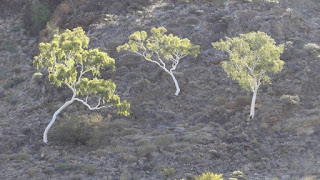Balranald
Three months ago (to the day!) we came through Balranald on our way to Sydney. Since then the flood waters have receded a little and it is amazing to see what effect on the environment they have! The two photographs below show the same area 3 months ago and now.
Lake Mungo
The first stop along our route to the Simpson desert is Mungo National Park, which forms part of the Willandra Lakes World Heritage Area. Lake Mungo is one of 13 ancient (now dry) lakes where the oldest human bones in Australia and the oldest human cremation were discovered.
View of the lake from the western side.
The eastern side of the lake has a crescent shaped "lunette" of sand which moves east >1m per year due to prevailing westerly winds. The layers exposed by the missing dune slowly erode and expose historic aboriginal camp sites, tools and bones. This is how Mungo Lady (estimated to be between 40,000 and 68,000 years old) and Mungo Man were discovered.
Since we are now travelling in style (by car rather than bicycle), we can indulge in luxuries while watching the sunset.
The eroded layers form some interesting patterns.
Note the sand blowing off the highest point of the dune - it was really moving when we were there! We both had our left ears filled with sand while climbing it!
Below is a replica of 20,000 year old aboriginal footprints (the originals have been reburied in sand to preserve them). The footprints in the middle seem to be missing the left foot....
Kirsten is cooking breakfast while trying to fend off the naughty apostlebirds.
We brought our down doona (another luxury we couldn't have on the bike rides), which makes our tent very warm and cosy! Double layer of therma-rest, flannel sheets, two pillows each and a down sleeping bag for when it gets really cold. Who needs a motel room??
Coober Pedy
The name Coober Pedy is derived from the aboriginal words for "white man in a hole". What a perfect name! Apparently opals were first found here in 1915 and there is still lots more to be dug out, supplying 80% of the world's opals. The town is riddled with holes and mounds and most people live underground.
Uluru & Kata Tjuta
The rock is always amazing, especially at sunset! No need for words....
The Olgas (Kata tjuta) from a distance....
... and up close.
Some notes on flora and fauna
It is amazing how there is always something blooming!! The different ecosystems are just gorgeous! In regards to fauna, here's the list in sequence of high to low numbers of sightings: cows, goats, emus, roos, sheep, cats, foxes, camels and a dingo. At least the natives didn't all end up at the end of the list.
Below two road trains loaded with feral camels on their way to the abattoir in Peterborough.
Dingo checking out the cars for a free meal.
Some of the flora...
Alice Springs
View of Alice Springs from ANZAC hill.
We were lucky to arrive in Alice Springs on the day of the "Henley-on-Todd" Regatta, which is a sailing, rowing and surf rescue competition in the dry river bed of the Todd River. It has been a yearly event for 51 years and had to be cancelled only once due to water in the river.
The "finale" was a gladiator-style battle between the three big ships, powered by four wheel drives and armed with flour mortars and high powered water cannons.
East MacDonnell Ranges
The ranges east of Alice Springs are much less visited by tourists but just as spectacular! I can never get enough of those white ghost gums (Corymbia papuana) clinging onto red cliffs and the old River Red Gums (Eucalyptus camaldulensis) along the watercourses! The gorges are beautiful and usually contain permanent water and sometimes provide habitat for colonies of the threatened Black-footed Rock-wallaby.
Trephina Gorge
Ghost gums..
...and a very artistic shot by Kirsten!
The bark of a River Red Gum.
Black-footed Rock-wallaby at John Hayes Rockhole
The "chain of ponds" in the Trephina Gorge Nature Park.
Arltunga Historical Reserve: Arltunga was a gold mining town of up to 300 people between 1887 and 1913. The miners could only reach the area by walking 600km from the Oodnadatta railhead. Many of the buildings have been restored and some of the machinery from the battery and cyanide works can still be seen.
Health & safety laws must be pretty relaxed in the Northern Territories. Some of the old mine shafts are accessible and interconnected.
Zebra Finch in the wild (as well as hundreds of budgerigars flying in formation).
A bearded dragon trying to be invisible.
The unsealed road to Ruby Gap is for 4WD only and was a great trial run to get acquainted with the abilities of our car (and the drivers!). Ruby gap is where David Lindsay found what he thought were rubies, which started a "ruby rush", only to discover that the stones were merely worthless garnets. The dry river bed is still covered in millions of small "rubies".
River crossing on the way to N'Dhala Gorge.
Once a jolly swagman camped by a billabong
Under the shade of a coolibah tree,
And he sang as he watched and waited till his billy boiled:
"You'll come a-waltzing Matilda, with me."

















































Really nice to touch base last weekend. We had beautiful campsite all to ourselves and got to try our new tent in rather drier conditions than it's inaugural outing. It looks like you have your marmot tent back by looking at the Doona photo. The wildflowers look spectacular, this must be the best time to be in the desert.
ReplyDelete